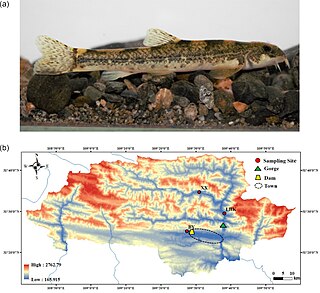Francis Buchanan FRS FRSE FLS, later known as Francis Hamilton but often referred to as Francis Buchanan-Hamilton, was a Scottish physician who made significant contributions as a geographer, zoologist, and botanist while living in India. He did not assume the name of Hamilton until three years after his retirement from India.

Pieter Bleeker was a Dutch medical doctor, ichthyologist, and herpetologist. He was famous for the Atlas Ichthyologique des Indes Orientales Néêrlandaises, his monumental work on the fishes of East Asia published between 1862 and 1877.

Johann Jakob Heckel was an Austrian taxidermist, zoologist, and ichthyologist from Mannheim in the Electoral Palatinate.
Dr. Ethelwynn Trewavas was an ichthyologist at the British Museum of Natural History. She was known for her work on the families Cichlidae and Sciaenidae. She worked with Charles Tate Regan, another ichthyologist and taxonomist.

The longnose catshark is a catshark of the family Scyliorhinidae found in the eastern central Pacific from central and southern California and the Gulf of California, between latitudes 38° N and 23° N, at depths down to 1,890. Its length is up to 58 cm.
Maurice Kottelat is a Swiss ichthyologist specializing in Eurasian freshwater fishes.

The bartail jawfish is a species of jawfish known only from reefs in the Atlantic Ocean off the coast of southern Brazil. This species can reach a length of 11.4 centimetres (4.5 in) SL. The specific name honours the French naturalist Georges Cuvier (1769-1832).
Triplophysa angeli is a species of stone loach in the genus Triplophysa. It is endemic to the Yalong River in Sichuan, China. It grows to 12.9 cm (5.1 in) SL.
Triplophysa arnoldii is a species of stone loach in the genus Triplophysa. It is endemic to Mongolia. It grows to 7 cm (2.8 in) SL.

Triplophysa bleekeri is a species of stone loach in the genus Triplophysa. It is endemic to China. It grows to 8.2 cm (3.2 in) TL. Having a wide distribution across the Qinghai-Tibet Plateau, it lives in fast-flowing rivers from 200 to 3,000m in altitude. Being an unusual species inhabiting high-altitude regions, it is an excellent model to investigate the genetic mechanisms of adaptation to the local environment. With this in mind a chromosomal-scale genome assembly was sequenced and assembled with a genome size of ∼628 Mb. This data finding that the Triplophysa genus likely diverged when the Qinghai-Tibet Plateau elevated by >4,000 m roughly 40 million years ago.
Triplophysa farwelli is a species of stone loach in the genus Triplophysa. It is found in Iran and the Helmand River drainage in Afghanistan.

The Tibetan stone loach is a species of ray-finned fish in the family Nemacheilidae. The specific name is sometimes spelled stoliczkae but the original spelling used by Steindachner is stoličkai. It is found in southern and central Asia.

Solomon Markovich Herzenstein was a Russian zoologist.
Gerald Robert "Gerry" Allen is an American-born Australian ichthyologist. His career began in 1963, when he spent a semester at the University of Hawaii, where he also received a PhD in marine zoology in 1971. In 1972, Allen wrote his doctoral thesis on the systematics and biology of the anemone fish.
Jean-Pierre Gosse was a Belgian biologist and ichthyologist.

Milyeringidae, the blind cave gobies, is a small family of gobies, in the order Gobiiformes. There are two genera and six species within the family, which is considered to be a subfamily of the Eleotridae by some authorities. Milyeringidae includes one genus (Milyeringa) restricted to caves in the North West Cape region of Australia and the other (Typhleotris) to underground water systems in Madagascar. They are all troglobitic species and have lost their eyes.
Helen K. Larson is an ichthyologist who specialises in the fishes of the Indo-Pacific.
Phillip Clarence Heemstra was an American-South African ichthyologist. He was born in Melrose Park, Illinois, United States as the son of Clarence William Heemstra and his wife, Lydia. He attended school in Ottawa, Illinois, and completed a B.Sc. Zoology in 1963 at the University of Illinois at Urbana, Illinois, as well as his MSc degree (1968) and doctorate (1974) in marine biology at the University of Miami in Miami, Florida. He moved to live in South Africa in 1978.

The Burmese mullet is a species of freshwater ray-finned fish, a mullet belonging to the family Mugilidae. It is the only species in the genus Sicamugil. It is found in the drainage systems of the Sittang and Irrawaddy rivers in Myanmar.
Triplophysa bellibarus is a species of stone loach in the genus Triplophysa.








